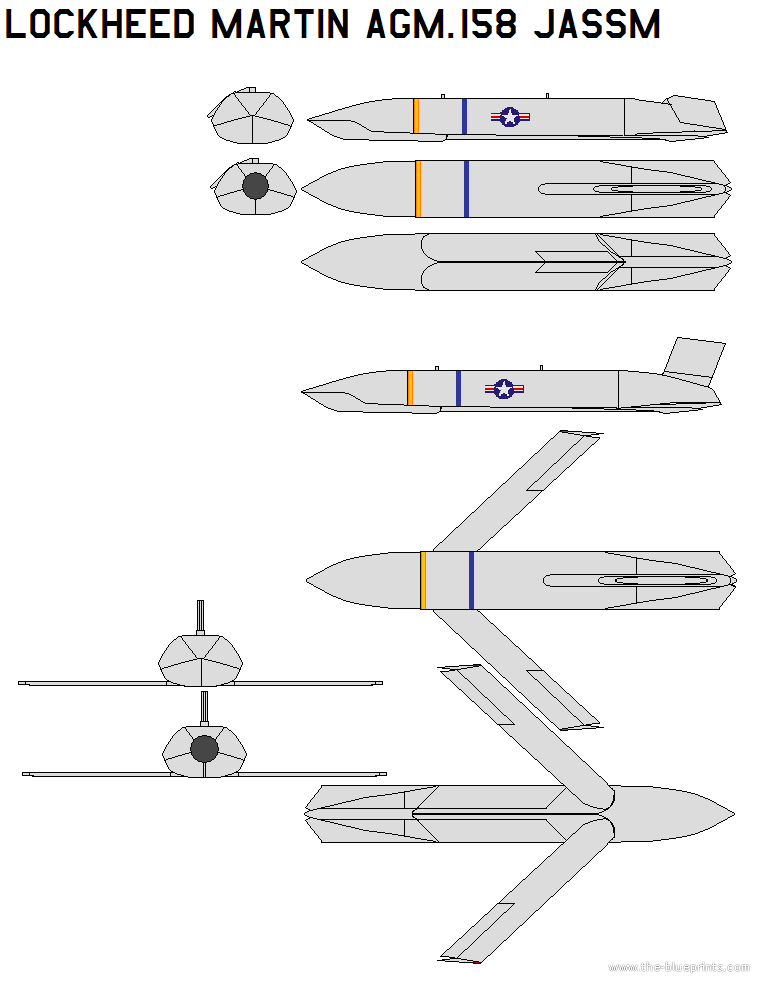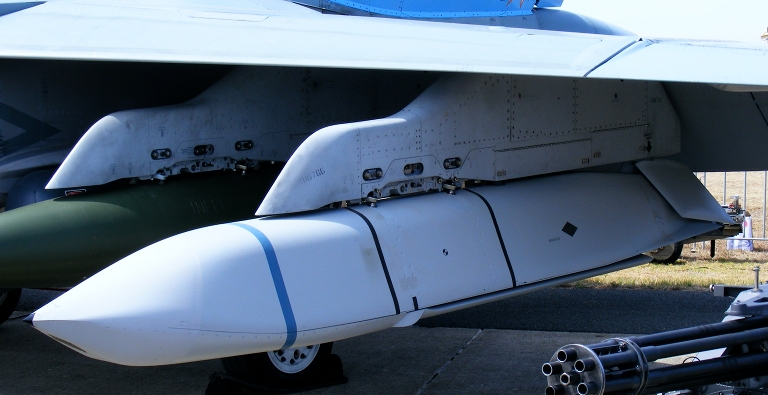The AGM-158 JASSM (Joint Air-to-Surface Standoff Missile) is a long-range, conventional, air-to-ground, precision standoff missile developed and produced by Lockheed Martin. This conventional missile was designed primarily for the US Air Force (USAF). Designed to destroy high-value, well-defended, fixed and relocatable targets, JASSM’s significant standoff range keeps aircrews well out of danger from hostile air defense systems.
It is a large, semi-stealthy long-range weapon of the 2,000 pounds (910 kg) class. The missile's development began in 1995, but a number of problems during testing delayed its introduction into service until 2009. As of 2014, the JASSM has entered foreign service in Australia and Finland, and been ordered by Poland.
The JASSM has the flexibility to be integrated into various platforms such as B-1, B-2, B-52, F-16, and F-15Eaircraft and is currently deployed on Australia's F/A-18A/B aircraft and Finland's F/A-18 C/D aircraft. It offers enhanced survivability, lethality and long-range precision strike to the warfighter during day and night operations.
Development
The AGM-158 JASSM (Joint Air-to-Surface Standoff Missile) program was initated in 1995 following the cancellation of the AGM-137 TSSAM (Tri-Service Standoff Attack Missile) because of high cost. Development goal was a low-observable long-range precision guided stand-off missile for significantly lower cost than the TSSAM. In June 1996, program-definition and risk-reduction contracts were awarded to Lockheed Martin and McDonnell Douglas (now Boeing). At the same time, the missile designations AGM-158A and AGM-159A were allocated to the two competing JASSM designs. In April 1998, Lockheed Martin won the development contract for the EMD (Engineering and Manufacturing Development) and full-rate production phase of JASSM. The EMD contract was extended several times by the US Air Force.
Lockheed Martin received an extension of programme definition and risk reduction contract in support of EMD in March 1999.
A first development test (DT-1) of the JASSM was successfully conducted in January 2001, and the operational capabilities of JASSM were subsequently demonstrated in April 2002. The JASSM proved its ability to perform in the presence of jammers in September 2002. The final development test of JASSM was conducted in March 2003 and the missile was certified for meeting warfighter requirements and operational capability in October 2003.
Lockheed Martin's JASSM-ER successfully performed its first development flight test in May 2006 and second flight test in August 2006. The USAF awarded a $32m contract in April 2006 for the development of a Weapon Data Link (WDL) capability enabling the JASSM-ER system to engage relocatable targets.
In March 2007 Lockheed Martin was awarded a $21m JASSM-ER Phase II development contract for procurement of 12 JASSM-ER operational test assets for additional testing.
The JASSM completed a successful Product Verification Test (PVT) in July 2011.
Design features and specifications of JASSM
The JASSM is a stealthy cruise missile integrating flip-out wings and a vertical tail. It is installed with a dual-mode penetrator and blast fragmentation warhead. The missile has a length of 4.35m and weighs approximately 1,000kg. It can carry warheads weighing up to 450kg.
JASSM can cruise with a subsonic speed, and has a range of 370.4km with the ability to reach targets within the range of 926km.
JASSM warhead technical details
The J-1000 warhead is designed with a dense metal case, or contains dense metal ballast for maximum penetration. The JASSM is installed with hard target smart fuse (HTSF), which differentiates between the earth, concrete, rock and air. The FMU-156/B fuse used in the warhead of JASSM employs a 150-gram PBXN-9 booster.
The 1,000lb class WDU-42/B (J-1000) penetrating warhead consists of 240lb of extremely insensitive explosive (AFX-757).
Guidance and navigation features of JASSM
The JASSM flies automatically through a predetermined route by using the onboard inertial navigation system that includes Anti-Jam Global Positioning System (AJGPS), and a ring laser gyro inertial measurement unit.
Additional navigation and guidance features on the air-to-surface missile include an imaging infrared (I2R) seeker, and automatic target correlator (ATC) for high precision strike rate. It can also carry powered low cost autonomous attack system (LOCAAS) sub-munitions integrating a dual mode laser detection and ranging (LADAR) system and a millimetre wave (MMW) seeker.
JASSM propulsion system
A Teledyne J402-100 turbojet engine powers the JASSM. It uses flip-out wings with control surfaces and a single vertical tail for flight control. The JASSM-ER is equipped with a Williams F107-WR-105 turbofan engine for significantly increased range of up to 1000 km (600 miles).
JASSM variants: JASSM and AGM-158B JASSM-ER
The JASSM is available in two variants; JASSM and JASSM-ER (extended range). Lockheed Martin will produce about 4,900 JASSMs for the USAF at its Troy manufacturing facility in Alaska.
The AGM-158A is powered by a Teledyne CAE J402 turbojet. Before flight the wings are kept folded to reduce size. Upon launch the wings flip out automatically. There is a single vertical tail. Guidance is via inertial navigation with updating from a global positioning system.
Target recognition and terminal homing is via an imaging infrared seeker. A data link allows the missile to transmit its location and status during flight, allowing improved bomb damage assessment. The warhead is a WDU-42/B 450 kg (1000 lb) penetrator. The JASSM will be carried by a wide range of aircraft: the F-15E, F-16, F/A-18, F-35, B-1B, B-2 and B-52 are all intended to carry the weapon.
AGM-158B JASSM-ER is an extended range variant of JASSM. It is intended to fly longer ranges (almost double the range of base JASSM) as it integrates a highly efficient engine and larger fuel tank. The missile can be integrated into B-1 aircraft. Although the B-1 is currently the only aircraft able to deploy it, it will be integrated onto the B-52, F-15E, and F-16.
The JASSM-ER was officially designated as AGM-158B in mid-2002, and the USAF awarded an SDD (System Development and Demonstration) contract for the AGM-158B in February 2004.
Low rate production of JASSM-ER was authorised in January 2011. The US Air Force successfully completed the initial operational test and evaluation (IOT&E) flight testing of JASSM- ER in May 2013.
Specifications
AGM-158A (JASSM)
Length: 4.27 m (14 ft)
Wingspan: 2.4 m (7 ft 11 in)
Weight: 975 kg (2,150 lb)
Speed: Subsonic
Range: 370 km (230 mi)
Propulsion: Teledyne CAE J402-CA-100 turbojet; thrust 3.0 kN (680 lbf)
Fuel:JP10 fuel
Warhead: 450 kg (1000 lb) WDU-42/B penetrator
Production unit cost: $850,000
Total program cost: $3,000,000,000
Production dates: 1998–present
AGM-158B (JASSM-ER)
Speed: Subsonic
Range: 1000 km (620 mi)
Production unit cost: $1,327,000
Propulsion: Williams International F107-WR-105 turbofan
Production dates: 2010–present
.jpg)

